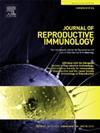Causal relationships between immune cells, inflammatory factors, and preeclampsia: A two-step, two-sample mendelian randomization study
IF 2.9
3区 医学
Q3 IMMUNOLOGY
引用次数: 0
Abstract
Background
Preeclampsia (PE) is a complex hypertensive disorder that occurs during pregnancy, with the immune system playing a key role. Although immune modulation is implicated in PE progression, the roles of specific immune cells and inflammatory mediators remain unclear.
Methods
We conducted a two-sample, two-step Mendelian randomization (MR) analysis, primarily using the inverse-variance weighted method, to investigate the causal effect of immune cell traits on PE. Additionally, we assessed the potential mediation effects of inflammatory factors.
Results
The MR analyses revealed that 22 immune cell traits exert protective effects against PE, whereas 19 are associated with an increased risk. Additionally, four inflammatory factors were suggested to be linked to PE. Mediation analysis identified the absolute count (AC) of CD33 + HLA DR+ cells, including the CD14 − subset, as causally related to PE. Both the total effect of the CD33 + HLA DR+ AC (odds ratio [OR] = 0.977, 95 % confidence interval [CI], 0.960–0.994; P = 0.010) and the effect of CD33 + HLA DR+ CD14 − cells (OR = 0.977, 95 % CI, 0.963–0.991; P = 0.001) were significant. These effects were partially mediated by STAM-binding protein levels, contributing 16.7 % and 15.0 % to the total effects of the CD33 + HLA DR+ AC and CD33 + HLA DR+ CD14 − AC, respectively.
Conclusion
This study establishes a causal relationship between specific immune cells and PE, potentially mediated by inflammatory factors, highlighting the importance of these traits in PE pathogenesis. Further research is needed to validate these findings based on larger, more diverse cohorts.
求助全文
约1分钟内获得全文
求助全文
来源期刊
CiteScore
6.30
自引率
5.90%
发文量
162
审稿时长
10.6 weeks
期刊介绍:
Affiliated with the European Society of Reproductive Immunology and with the International Society for Immunology of Reproduction
The aim of the Journal of Reproductive Immunology is to provide the critical forum for the dissemination of results from high quality research in all aspects of experimental, animal and clinical reproductive immunobiology.
This encompasses normal and pathological processes of:
* Male and Female Reproductive Tracts
* Gametogenesis and Embryogenesis
* Implantation and Placental Development
* Gestation and Parturition
* Mammary Gland and Lactation.

 求助内容:
求助内容: 应助结果提醒方式:
应助结果提醒方式:


